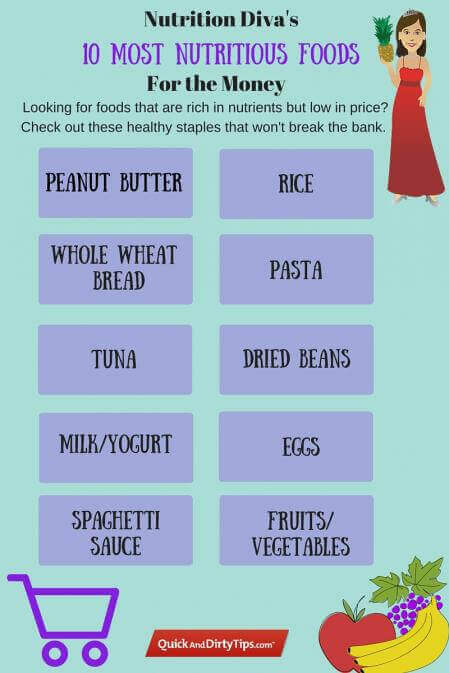The 10 Most Nutritious Foods for the Money
You can get all the nutrients – and calories – you need for less than $5 a day. Nutrition Diva shows you how with this list of 10 healthy and wallet-friendly foods.

See also: Nutrient Density vs. Energy Density
For those with a limited food budget, it often feels like you have to choose between getting enough nutrients and getting enough calories. You don’t. As I will demonstrate, it is possible to put together a nutritionally complete and balanced diet for less than $5 a day.
The 10 Most Nutritious Foods for the Money
Here are 10 nutritious but inexpensive foods that can be mixed and matched to put together a healthy diet, along with an infographic to help you remember. The prices are from my local grocery store, and while you can save money by buying large volumes, these prices are for regular sizes…although I did take advantage of the savings on generic brands.
Peanut Butter
Peanut butter is a good source of protein and vitamin E, and at about 12 cents a serving, it’s also a real bargain. You can spread it on toast for breakfast, dip carrots or apples into it for a snack or, if you’re a bit more savvy in the kitchen, use it to create an Asian-style sauce for veggies and noodles.
See also: Allergic to Peanuts?
Whole Wheat Bread
Although you may think of bread as a carb, 2 slices of whole wheat bread have as much protein as a serving of peanut butter, making that PB&J a real protein powerhouse. At about .11 a slice, it’s also wallet-friendly.
See also: Multi-grain vs. Whole-grain
Eggs
For an inexpensive source of complete protein, you can’t do much better than the incredible, edible egg—about 16 cents a piece. You can scramble them for dinner, hard-boil them for a snack, or use them as the basis for a quick and nutritious supper.
If you have a copy of my book, Secrets for a Healthy Diet, try the Vegetable Frittata recipe on page 200. Not only is it one of my favorite suppers, but it also uses up leftover vegetables – and avoiding food waste is another great way to save money.
See also: 9 Tips for Reducing Food Waste
Tuna
Canned tuna is another great source of protein, but with an added bonus: omega-3 fats. You can make tuna salad for your lunch or a tuna noodle casserole for dinner. A serving costs just 45 cents.
See also: What’s the Healthiest Kind of Tuna?
Pasta
With about 7 grams per serving, pasta is another under-rated source of protein. It’s also the basis for an infinite variety of inexpensive and satisfying meals, from traditional pasta with red sauce and the aforementioned tuna noodle casserole to a vegetable-packed minestrone soup. Best of all, you’ll pay just 12 cents a serving.
See also: How to Reheat Leftover Pasta
Spaghetti Sauce
Cooked tomatoes are an excelle
nt source of antioxidant vitamins, a versatile pantry ingredient, and will only set you back about 20 cents a serving. So stock up on pasta sauce, or canned tomatoes to make your own.
Dried Beans
No list of cheap-but-nutritious foods would be complete without dried beans. You’ll get a meal’s worth of protein, plus a whopping helping of fiber, for just 12 cents as serving. With dozens of types available, beans are also extremely versatile. Combine them with different vegetables and spices for a nearly infinite variety of dishes.
See also: Freeze Those Beans
Rice
A natural pairing with beans, rice can also be used in salads, soups, and casseroles, and costs about a dime per serving.
See also: Is Brown Rice Really Better Than White Rice?
Milk or Yogurt
At about .25 a serving, milk provides plenty of protein and absorbable calcium. Yogurt will cost you about twice as much, but offers the additional benefit of beneficial bacteria. You’ll pay less (and get more nutritionally) if you choose unsweetened yogurt.
Fruits and Vegetables
You can save money on produce by buying whatever fresh fruits and vegetables are on sale that week and then filling in the gaps with frozen fruits and vegetables. Although there’s a pretty big price range in this category, you can find a good variety of things for between 25 and 75 cents a serving.
A Final Note
Of course, you’ll also need things like oil and seasonings to cook with, and probably a condiment or 2, too. And hopefully there’s enough room in the budget for some additional variety – and the occasional treat. But as the backbone of an inexpensive, nutritious diet, these 10 foods are an awfully good place to start.
In fact, I priced out a week’s worth of just these 10 foods – enough to provide 2,000 calories a day, and meet all your nutritional needs for things like protein, fiber, vitamins, minerals, fruits and vegetables. I even threw in some olive oil to dress your salad and cook your eggs, and the whole tab came to about $4.11 a day.
Of that, I spent about $1.80 on fruits and vegetables—which brings me to an important point: if you’re only looking at how many calories you get for the dollar, fruits and vegetables look like a pretty bad deal. Even though I shopped for bargains, my fruits and vegetables accounted for about 44% of my costs and provided only 15% of the calories.

Now, how do I get this list over to Gwyneth Paltrow?
Thoughts? Comments? Questions? Connect with me on Facebook and Twitter. And for more on maximizing nutrition while saving money, see my e-book Nutrition Diva’s Grocery Store Survival Guide.
Image of grocery basket courtesy of Shutterstock.






